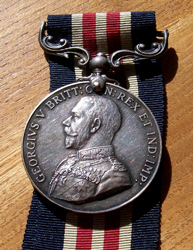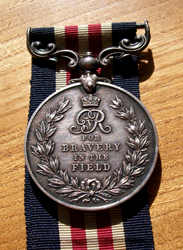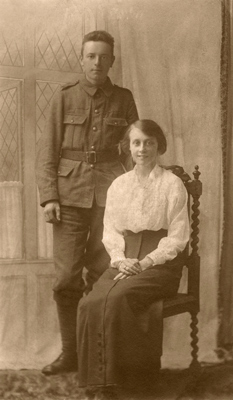In November 1917 the Regiment was fighting near Gaza. It was not a peaceful Christmas because the Turks were determined to recapture Jerusalem. Orders then came to leave because there was typhus in Jerusalem. In March 1918 the battalion moved to Wadi Neriamen to support the crossing of the Jordan, but the crossing was unsuccessful because of the strong current. They crossed the Jordan on April 1
st and marched to a point NE of Jericho. Further advance was held up despite heavy fighting and they were withdrawn during May because their position was exposed.
After a period of training and defence construction, including a four day period when they worked night and day, they marched to Lod (Lydda) and then onwards by train to Kantara (El Quantara) and again to Alexandria for embarkation on 'HMT Indara', which sailed on 18
th June 1918. In the Gulf of Taranto at 1am on 21 June a U-boat made an unsuccessful attack on the ship. Lewis never mentioned this and may not have known about it.
From Taranto they went to France by train arriving at Hazebrouck on 1
st July. From here they marched in stages until they reached "Locre Sector" in Belgium where they held the line until 3
rd August. After intermittent periods in the front line they were relieved on the 20
th August and moved back to reserve. The 2/16 London Regiment was now split into A, B and C Companies and Sergeant Lewis Jones was with B Company.
On the 27
th September.the 90th Brigade was ordered to advance. The 2/16 London Regiment maintained its position until the 28th and then attacked and took their first objective just west of Messines. The objectives were held overnight. The war diary shows the regimental casualties as 3 officers and 16 other ranks killed in action, and 5 officers and 79 other ranks wounded during the period 28
th to 29
th September. Lewis said that their Medical Officer was the first to fall (the war diary records that "Capt. K Elmes (RAMC attd) killed in action").
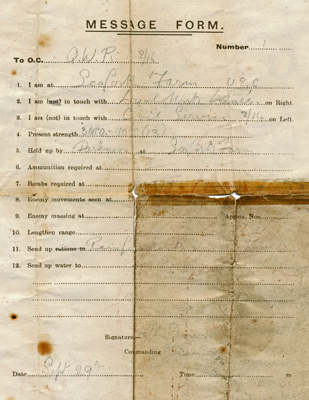
|
Sergeant Lewis Jones used the message form on the reverse of his trench map to write:
To O.C. Q.W.R. 2/16
1. I am at Seaforth Farm U8C
2. I am in touch with Loyal North Lancs on Right
3. I am not in touch with Civil Services 2/14 on Left
4. Present strength 3 NCO + 10 OR (13)
5. Held up by Darkness at Seaforth Farm
11. Send up Reinforcements soon as possible
Signature Sgt Jones
Commanding B Co
Date Sept 29th
This message was never sent and is still held by his family.
|
Seaforth Farm was just south of Messine about nine miles northwest of Lille. The Loyal North Lancs had also taken heavy casualties. As senior NCO Lewis Jones led what was left of the two companies. For his actions at this time Sergeant Lewis Jones was awarded the Military Medal.
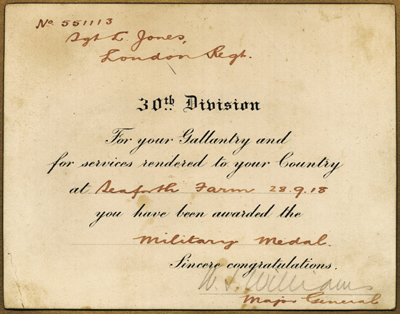
|
Lewis Jones' citation reads:
No 551113
Sgt L Jones,
London Regt.
30th Division
For your gallantry and for
services rendered to your Country
at Seaforth Farm 28.9.18
you have been awarded the
Military Medal
Sincere congratulations
W. J. Williams
Major General
|
Many years later Lewis Jones said that on that night he was preparing to repulse an expected counter attack. He had an additional problem of a number of enemy prisoners including an officer. He told the officer to return to the German lines with the other prisoners. The officer was reluctant at first, fearing they would be shot for "escaping", but they left under cover of darkness.
The regiment was then in the rear until 16
th October 1918 when they moved into the front line again and began to advance, whilst the enemy was beginning to withdraw. Lewis Jones said he was in the village of Autryve (Outrijve near Kortrijk) in Belgium on 11
th November 1918 when the war ended, and there was a Thanksgiving service
After a period of parades, company football and concerts the regiment started to move for home. He travelled to Calais by train and from the 25
th December 1918 groups of about 25 men were sent back to England for demobilisation. At Crystal Palace in South London he left the army on 18
th March 1919. On 9
th August 1919 Lewis Jones married Annie Frances Carpenter. He returned to work for the Silver Studio after the war.
This war biography was written by Lewis Jones' son Robert Jones, with help from other family members. A full biography of Lewis' life and career can be found at
www.mooch.org.uk/serious/lewis_biog_00.html.
*Additional information for this history was derived from the book "Some unofficial adventures of the 2
nd Battn 16 London Regt The Queen's Westminster Rifles 1914-1916" by Adjutant Mare, held at
The National Army Museum in Chelsea, and also from the "War Diaries" held at
The National Archives. Using these sources it has been possible to give dates and more details of this part of Lewis Jones' life.
This biography is Copyright © 2012 by Robert Jones. No text or images may be used, copied or otherwise reproduced for commercial purposes without a specific permission. Text and images may be used for educational and personal use if explicit acknowledgements to their source are included.

